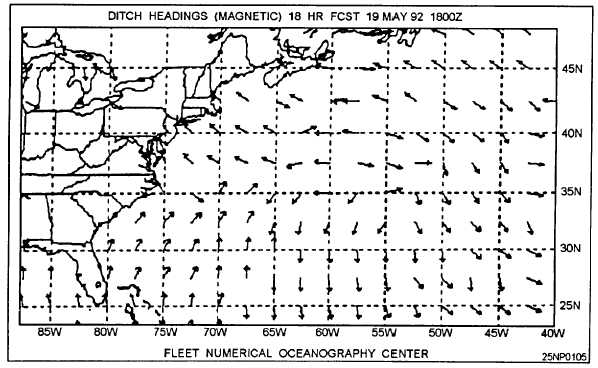PRODUCT AVAILABILITY
considerations when ditching becomes necessary are as
follows:
The ditch headings product is available as an
analysis and as a forecast at 12-hour increments to 72
hours. See figure 10-3.
PRODUCT EXPLANATION
The Global Spectral Ocean Wave Model
(GSOWM) primary swell direction and primary wave
height fields and Navy Operational Global Analysis and
Prediction System (NOGAPS) marine wind direction
and velocity fields are used to calculate the optimal
direction to land an aircraft. The earth’s magnetic
variations are used
heading.
PRODUCT USE
. If only one swell is present, landing should take
place parallel to the swell, preferably on the top or
backside of the swell.
. If two or more swell systems are present, and the
primary system is significantly higher, landing should
take place parallel to the primary swell. If the swell
systems are comparable in height, landing should take
place at a 45-degree angle to both swell systems on the
downside of the swell.
. If the secondary swell system is in the same
direction as the wind, landing should take place parallel
in the final calculation of the
to the primary swell with the wind and secondary-system
at an angle. The choice of whether to land with the angle
of the wind upwind or downwind to the plane depends
on the wind speed and height of the secondary swell
The ditch headings product is generally used in
preparation of a transoceanic flight weather packet. In
case of distress, the pilot must make a decision on which
direction to land an aircraft to minimize impact damage
to the aircraft and loss of life. Except in calm seas,
ditching an aircraft is more complicated than landing
into the wind. Large waves can severely damage
aircraft upon impact. Ditch headings are used primarily
in instrument flight rule (IFR) conditions when a pilot
system.
. In all cases, if the swell system is huge, it is
advisable to accept more cross wind than to land into the
swell.
PRODUCT LIMITATION
The ditch headings product does not take into
account secondary swell conditions. For further
information, refer to the NODDS Products Manual,
cannot observe the sea conditions.
The general
FLENUMMETOCCENINST 3147.1.
Figure 10-3.-Example of the ditch headings product.
10-10

